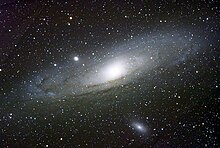Light year
| Physical unit | |
|---|---|
| Unit name | Light year |
| Unit symbol | |
| Physical quantity (s) | length |
| Formula symbol | |
| dimension | |
| In SI units | |
| Derived from | Speed of light , Julian year |
| See also: parsec , astronomical unit | |
The light year is a measure of length that is common in astronomy to indicate great distances. It is defined as the distance that light travels in vacuum during a Julian year . That is 9.46 trillion kilometers (9.46 · 10 12 km). Even if the name contains the word “year”, the light year is not a unit of time .
use
The light year is an astronomical unit of length . It is often used to indicate cosmic distances in astronomical public relations. In the scientific environment, however, Parsec is more common.
As with any unit of length, a spatial measure for specifying volumes can also be derived from the light year by exponentiation. In this case, this results in the unit cubic light year , which corresponds to the volume of a cube with an edge length of one light year (= 8.4673 · 10 47 m³).
definition
According to the International Astronomical Union (IAU), a light year is defined as the distance that an electromagnetic wave like light travels in a vacuum in a Julian year. There are several definitions for a year . So there is the tropical year , the Gregorian year , the Julian year and the sidereal year . These deviate from each other by up to 0.005 percent, which leads to divergences if the information is more precise. The International Astronomical Union has therefore recommended that a "year" without further details should be interpreted as a Julian year (= exactly 365.25 days). Analogous to the light year, the units light second , light minute , light hour and light day are defined.
In the International System of Units (SI), the unit " meter " is defined by the speed of light, which was fixed with the value 299,792,458 m / s. Therefore, a light year corresponds to an exact whole number of meters:
Light second: 1 Ls = 299,792,458 m ≈ 3.0 · 10 5 km = 300,000 km Light minute: 1 ch = 17,987,547,480 m ≈ 1.8 · 10 7 km = 18 million km Light hour: 1 lh = 1,079,252,848,800 m ≈ 1.1 · 10 9 km = 1.1 billion km Light day: 1 Ld = 25,902,068,371,200 m ≈ 2.6 · 10 10 km = 26 billion km Light year: 1 ly = 9,460,730,472,580,800 m ≈ 9.5 x 10 12 km = 9.5 trillion km
Furthermore, one light year corresponds approximately
63,241 AU ( Astronomical units ) or 0.306 6 pc ( Parsec ).
Examples

- The mean distance between the earth and the moon is about 1.28 light seconds.
- The mean distance between the sun and the earth is approx. 497 light seconds (8.28 light minutes).
- The mean distance between the Sun and Neptune is about 4.17 light hours.
- The limit of the heliosphere is about 16.6 light hours away.
- The closest star to the Sun, Proxima Centauri , is about 4.24 light years away.
- The diameter of our galaxy , the Milky Way , is 170,000 to 200,000 light years.
- The distance to the next major galaxy, the Andromeda Galaxy, is 2.4 to 2.7 million light years.
- It is about 46.6 billion light years to the limit of the observable universe .
See also
Web links
swell
- ↑ IAU side to measurements (English)



